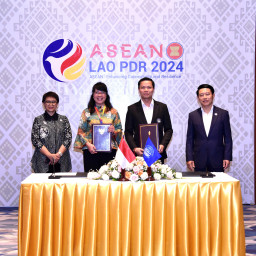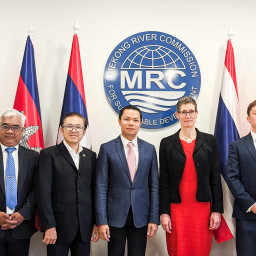Mekong water levels higher than average despite local concerns
7 March 2014, Vientiane, Lao PDR— Water levels on much of the Mekong River have been higher than the long-term average since November last year with unusual fluctuations observed in last December and February, according to monitoring and forecasting data from the Mekong River Commission (MRC).
According to recent media reports, residents from some riverside communities in the border between Thailand and Lao PDR have raised concerns over unusual fluctuations in water levels along the Mekong River, including what they consider to be lower-than-normal levels for this time of the year.
The MRC’s data shows that water levels have been significantly above normal (or the long-term average) for most mainstream monitoring stations in Lao PDR, Thailand and Cambodia since November 2013 and in many cases above the earlier highest record for this time of the year.
For example, water levels in Chiang Saen district of Chiang Rai Province in northern Thailand have almost continuously been 1.5 to 2 metres above the long-term average. Further down the Mekong, for example at Vientiane, Lao PDR, one can still observe a water level of 1 to 1.5 metres above the average. In Kratie, Cambodia, the current water level is higher than what had consistently been observed during February and March in the past.
However, the MRC observed unusual fluctuations in water levels and flows. As reported on earlier a sudden peak in water flows in mid-December 2013 saw the water levels rise above the earlier recorded highest level for this time of the year. This is believed to be caused by the unusually high rainfall in southern China and northern Laos.
During the first two weeks of February 2014 the water level in Chiang Saen dropped rapidly by 1 metre but the dropped level was still far above the long term average. The water level then quickly returned to high levels and is currently much higher than ever recorded for this time of year.
The rapid changes in the beginning of this year suggest that the water level is influenced by human activities (as there was no associated rainfall). The unseasonably high flow and the rapid drop in water level at the upper Mekong may be determined by water releases of the cascade reservoirs on the Lancang for energy production and possibly navigation purposes. The MRC is inquiring with the Chinese authorities on this issue.
Local man-made activities, such as sand dredging, can change the sediment flow and morphology at certain stretches of the Mekong and can consequently cause unusually low water levels at respective areas, although the water volumes remain high.
During the dry season the MRC provides a weekly update on water levels observed in the previous week and water levels forecasted for the upcoming week at 22 water monitoring stations on the Mekong mainstream. The information is available on the MRC’s website: www.mrcmekong.org and its flood forecasting website http://ffw.mrcmekong.org.
Notes to editors:
The MRC is the intergovernmental body responsible for cooperation on the sustainable management of the Mekong Basin whose members include Cambodia, Lao PDR, Thailand and Viet Nam. It is established to promote cooperation amongst the Member Countries and thus it is not a supra-national or regulatory body.
In dealing with this challenge, the commission looks across all sectors including sustaining fisheries, identifying opportunities for agriculture, maintaining the freedom of navigation, flood management and preserving important ecosystems. Superimposed on these are the future effects of more extreme floods, prolonged drought and sea level rise associated with climate change. In providing its advice, the MRC aims to facilitate a broad range of dialogue among governments, the private sector and civil society.
The MRC Secretariat provides technical, advisory and administrative services to the member states. It facilitates regional meetings of the Member Countries and provides technical advice on joint planning, coordination and cooperation. It also works closely with the four countries’ coordinating bodies, the National Mekong Committees (NMCs), and other state agencies. Currently, the People’s Republic of China and the Union of Myanmar are engaged as MRC Dialogue Partners.





